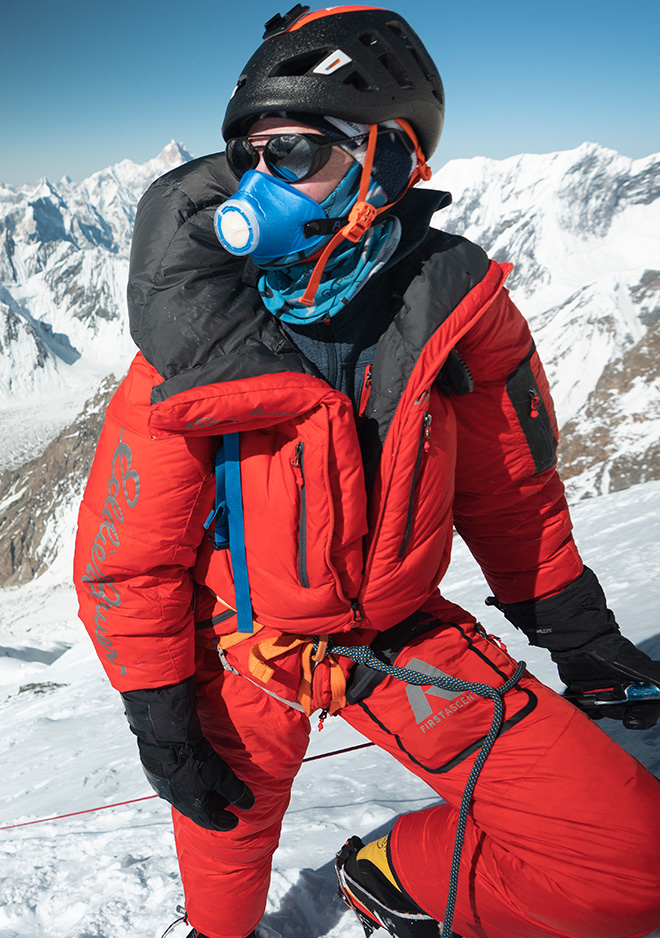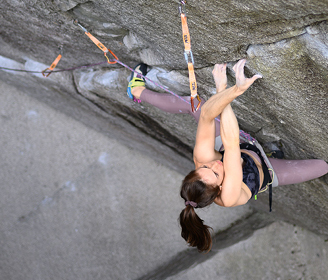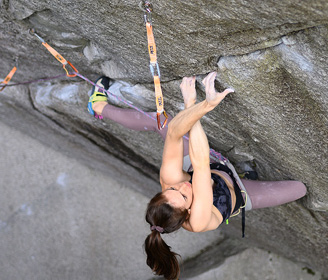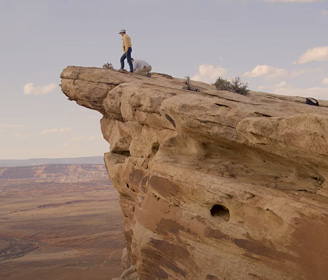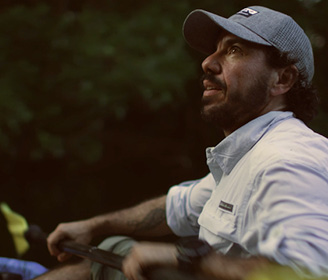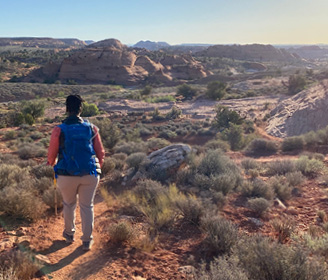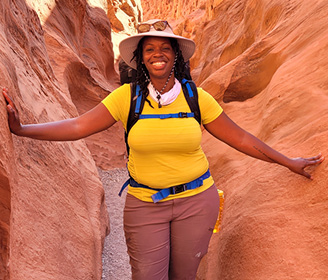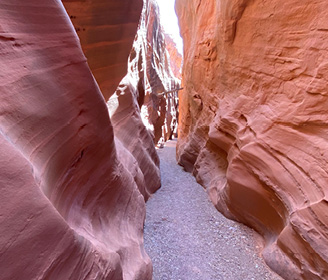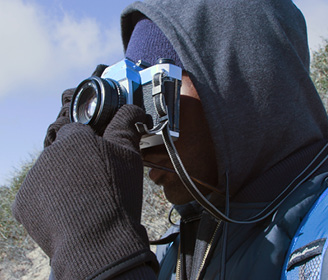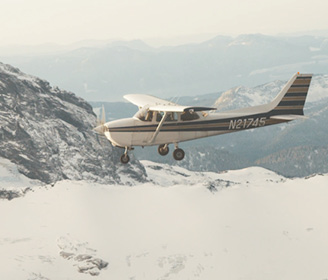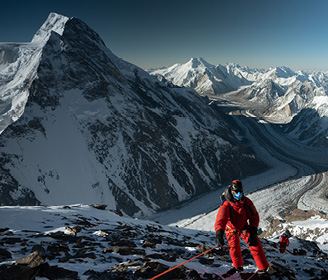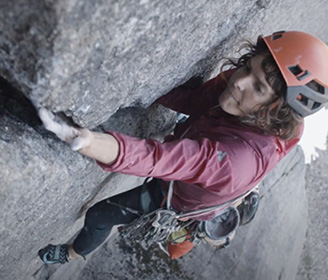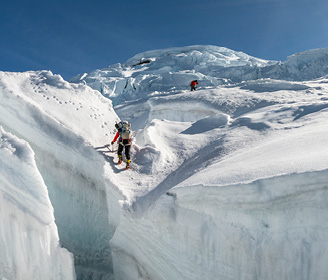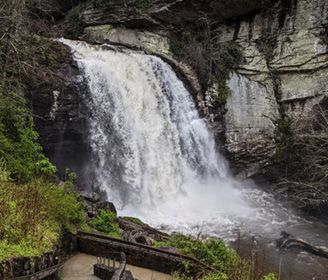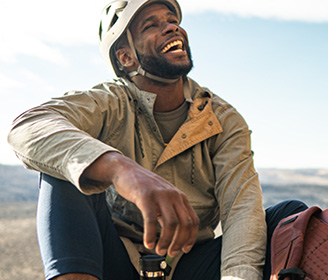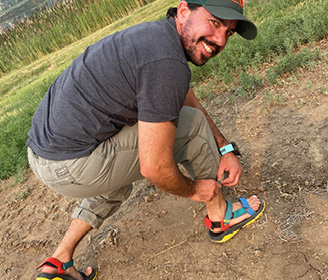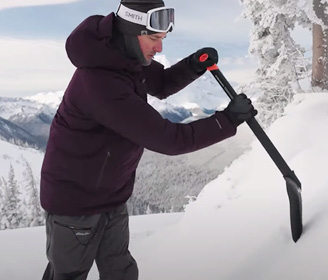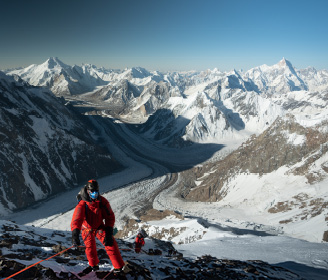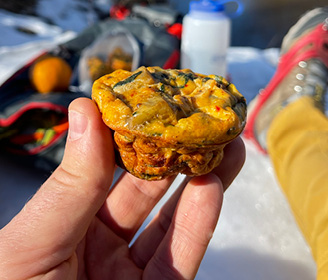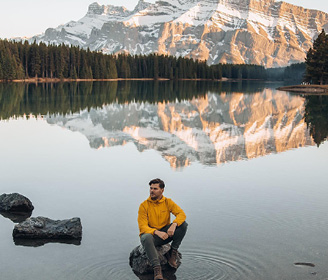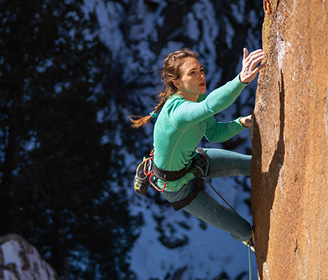Whitewater kayaking may seem like a niche sport, but it can be quite accessible and very thrilling. Learn exactly what Whitewater Kayaking is, how to find the right kayak for you and how to roll your kayak in a river from Eddie Bauer Kayak Athlete, Ben Stookesberry.
Watch the video above!
Meet The team
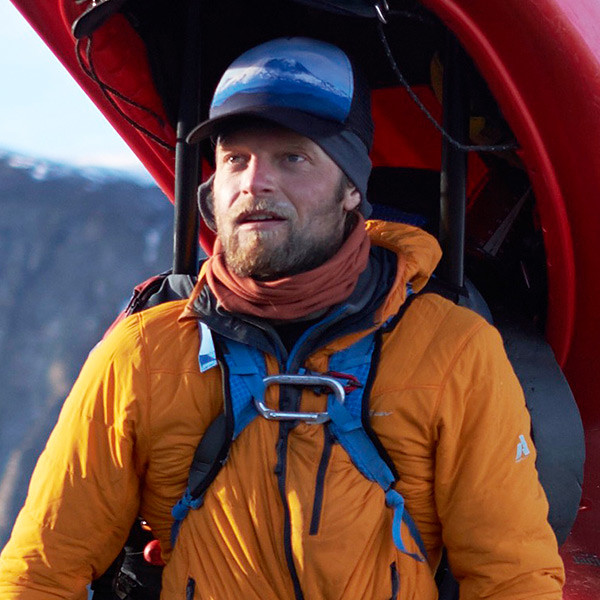
BEN STOOKESBERRY
Eddie Bauer Exploration Guide
Stookesberry has been the expedition instigator for more than 132 first descents on sections of Class V or Class VI rivers in 36 countries. A talented filmmaker and visual storyteller, he won a Best Adventure Film award at the Banff Film Festival for his 2011 film Kadoma and received critical acclaim for Walled In.
What is whitewater kayaking?
Oh my God, that’s sort of an existential question. Whitewater kayaking is kayaking in an enclosed vessel in a river with turbulence, and using a paddle that has two blades on either side. Maybe that’ll work. Next question.
What’s the difference between whitewater and flat water kayaks?
In general. whitewater kayaks are going to be a lot shorter and have a lot more of a planning hole, like a surfboard and less of a keel, like a sailboat. In whitewater scenarios, We want to be as maneuverable side to side and be able to change our angle really quickly. Whereas in a recreational kayak. usually your main concerns are speed across the water and stability. And so you have a really wide vessel. and also have a bit of a keel so that it goes really quickly in a long water line. But you can use a whitewater kayak in recreational kayaking scenarios, but it doesn’t apply where you can use a recreational kayak in whitewater kayaking scenarios
How to roll a whitewater kayak?
Oh my God. In terms of how you do it, it’s tempting to think that it’s all in the arms. When you see a whitewater kayaker in a video, it looks like they’re using their paddle quite a bit, but in fact, counterintuitively, it’s really all about the hips, and the movement, and the coordination between your core strength and your lower body, and transferring energy from your hips into your knees and your legs, and driving the kayak underneath you. There’s all sorts of different methods and techniques that you can use to actually accomplish the roll but at its very foundation, it is this movement that takes place in your hips and your lower body. Next question.
What are the different types of whitewater kayaking?
We have six different classifications of whitewater. Class one, which just implies moving water. Class two, which is a little bit of ripples, small waves, nothing that even a beginner in the sport couldn’t accomplish safely. Class three, now you’re starting to talk about having to have some level of skill in order to make it downstream still in your kayak. Then again, the risk level of not making it, of having to come out of the boat and swim to shore is still relatively low. Then we go up to class four, where again, it’s more difficult to navigate. And also that comes with an increase risk and danger of actually not hitting the line, not staying in your kayak. There’s oftentimes rocks in the rivers, there are strong currents. And so, at that point you need to be more of an advanced kayaker. And sometimes that takes months, if not years in the sport to get to the level of class four, which would really be almost like getting to a black diamond on a ski hill. And then we’d start talking about class five kayaking, which is more akin to back country skiing, double diamonds at a resort. We’re starting to starting to talk about the extreme of our sport, where it’s extremely turbulent. There’s a lot of rocks in the river. There’s incredibly strong currents that your life jacket might not even help you float. In some cases, your kayak is actually going to get sucked down below surface. You need to be an expert in order to run class five. And then we even have a class six designation, which, in general terms, is considered to be unreasonable. But at certain water levels with a group of experts, we define even class six as being runnable. And once we are able to accomplish class six more than once, if it’s more than just a one off stunt, we can begin to talk about that particular rapid and feature in terms of class five. So in my mind, there are really five types of whitewater kayaking, in general, from a very beginner level to the most expert, the most extreme level of whitewater kayaking. Next question.
Is it harder to whitewater kayak when you’re overweight?
So whitewater kayaking is, I think, such an amazing sport because it allows for a full spectrum of body types to get into the boat. There are boats that accommodate larger individuals, and boats that accommodate little kids. So I think in that way, it’s a tremendous opportunity for again, for people of all body types, all ages to enjoy these natural spaces, because in the river, it’s the river we’re using. We’re utilizing the river current and the river is really pulling us downstream. That being said that, there’s all sorts of opportunities to be as physical in the river and to push yourself to the very limit of physical exhaustion. And then there’s also the type of rivers that can accommodate someone who’s never paddled in the river, but can get in the whitewater kayak, feel comfortable, and float down the river and see these beautiful places.
How should my kayak fit?
Your kayak should fit comfortably. A lot of times we’ll sit in the river for hours at a time. And so you want your kayak to fit so that your legs don’t go to sleep. It makes it much more comfortable, much more enjoyable. One of my favorite aspects of whitewater kayaking is actually going downstream and being able to enjoy the beautiful canyon walls, or the forest around me, and not having to be in pain or be uncomfortable in my kayak. So I think that the primary objective for any first time kayaker should be just to be comfortable in your boat. Now, when we start thinking about actually being able to maneuver the kayak as well and as precisely as possible, we want the kayak to start to fit like a ski boot, and anybody who’s been skiing knows that fitting a ski boot is this balance between comfort and pain. You want to be as tight in that ski boot. You want to be as tight and as snug in your kayak as possible, but yet you want to be able to stay in that kayak, potentially, all day and enjoy yourself without being in pain. So, it really is just like fitting yourself in a pair of ski boots, except, instead of just your foot going in, it’s your whole lower body. Next question.
Why do people whitewater kayak?
Well, I can only really speak for myself but I find it just to be this ultimate expression of of freedom, a great way to get exercise, to breathe deeply but to be in a place that is so beautiful. These rivers, the best rivers, the ones that I dream about, are free flowing rivers. And so you’re really engaging with this incredibly natural and powerful space. And while just, you’re filling yourself full of endorphins from the experience, from the speed of the river, from the splash of the cold water in your face, from the sight of this beautiful riparian vegetation, forests all around you, also going over a waterfall is an incredible rush of adrenaline. If you’re not as into the aesthetics as I am, the adrenaline is something that is unmatched in anything else that I’ve tried. Next question.
How to splat with a whitewater kayak?
Splatting a whitewater kayak, I guess, would come from the idea of splatting a fly on a window, except in the river. And we can actually smash our whitewater kayaks, or lay them flat against the face of a boulder or a cliff face along the side of the river. And in order to do that, we need to perform what’s called a stern squirt. And all of the maneuverability of your kayak is available to you once you learn how to roll your kayak, because inevitably, putting your kayak on end and putting your kayak in the most unstable and unpredictable of positions, which is a vertical position, will inevitably require you to go upside down and roll back up. So the first thing to do to split your kayak is learn your whitewater rule. The second thing that you want to do is be able to engage the stern of the kayak. And the stern of the kayak is the rear of the kayak, and in the sort of kayak that we’re going to be able to splat a rock in, the stern is going to be shaped almost like a spoon. And we’re going to be able to push and pry the stern down with a reverse stroke, push it down into the water, make the kayak go vertical and actually put the kayak splat on the face, flat on the face of the boulder. And go ahead and cruise downstream, and make this beautiful maneuver on the stern. Incidentally, you can splat a kayak from the bow of the kayak, from the front, and it would just be the opposite maneuver. Instead of engaging your stern, you’re engaging the bow. So you’re pushing the bow of the kayak down. You’re going vertical on the nose of the kayak. And then from there, you can change and reverse, and do cartwheels along the face of the rock. And we actually call those splat wheels. I don’t know who came up with these names.
How long should my whitewater kayak be?
Your whitewater kayak should be as long as you need it to be. Which means that different kayaks are made for different types of rivers, different goals in those rivers. If you’re trying to go really fast and trying to cover a long distance, in general, you’re going to want a kayak that’s much longer, much more voluminous, has a lot more volume, a lot more spaces, a lot more comfortable. If you’re trying to engage with the river, doing play maneuvers, surfing on a wave. A lot of times you’re going to look for a kayak that’s a lot shorter. That looks more like a surf board. Might be as short as even five and a half feet long. So you’re looking at anywhere between five and a half feet and 13 feet long. Next question.
Where can I learn to whitewater kayak?
So the best places to learn the whitewater kayak are in places with a river that has clean water, warm ambient temperatures, and has an instructor that is qualified by the ACA or any number of other governing bodies across Europe, South America, making sure that you have someone with you that knows what they’re doing, that can give you those foundational elements of a good, solid, safe start in the sport. But also, the venue is extremely important. Clean water, warmish, as warm a water as possible to make it comfortable when you’re learning how to roll, go upside down, swimming a lot, and then also, warm ambient temperatures, in order to just enjoy yourself and then spend as much time in the water as possible. Certainly, trying to learn how to kayak in the middle of the winter when it’s snowing and when it’s extremely cold is going to be a lot different than learning how to kayak in the middle of the summer when it’s a hundred degrees out and the only thing you want to do is get in the water.
How to pack gear in a whitewater kayak?
Packing gear in a whitewater kayak is all about the kayak that you choose for the particular river. If you’re in a kayak that’s made for surfing waves, that’s made for playboating, This is going to be a lot smaller, and it’s going to be a lot harder to pack gear into. On the other hand, if you’re in a kayak that has a lot of volume, that’s a longer kayak, and is really made for going downstream, and even spending multiple days and nights on the river, this kayak is going to have large spaces in the front, both in front of your feet and behind your hips, in order to pack here in that kayak. And when you pack the gear in the kayak, you want to put it inside of a dry bag that is waterproof, so that your sleeping bag comes out nice and dry. Your food comes out and it’s not all mushy with river water, and your camera is still functioning too. So, it’s a combination of the space inside your kayak, and then packing the gear into those spaces inside of a dry bag. Next question.
What are tips for controlling a whitewater kayak?
Well, controlling a whitewater kayak is all about practice. The best place to practice is the place where you’re the most comfortable in the river. And for a beginner paddler, oftentimes the best place to practice is going to be in flat water, either in a lake or in a pool. And that’s a place where you can really focus on what your paddle strokes do to the kayak, and not worry so much about the currents coming in, and making you feel tippy. And so, you just want to start in a place where you really zero in on how your body position affects the kayak, how your strokes affect the kayak, how your hip tilt affects the kayak. The best tip for controlling the kayak that I can give you is just a lot of practice, initially in flat water. And then as you become, say, for example, once you become a class three paddler, the best place for you to practice your skills is going to be on class two or below, because that’s the place where you can forget about the stress or the excitement, and you can really focus in on your paddle strokes and your body positioning.
How long should my whitewater kayak paddle be?
That is a really good question. But let’s just say your whitewater kayak paddles should be to six inches taller than you are, depending on what sort of whitewater kayaking you’re doing. In a play boat, you’re going to want to paddle that’s shorter. In a river running kayak, where you’re just taking strokes and trying to go downstream as quickly and efficiently as possible, you’re going to want a longer paddle. I don’t know if that’s the official definition, but I kind of just made that up off the top of my head. Let’s go with that. Next question.
What does it mean to portage a kayak?
Aha, this is actually what I’m best at. Portaging a kayak is the ability to carry your kayak overland. And we’ll use that to actually get into a remote river that has no road access, or we’ll use that to get around sections of the river we don’t want to kayak because they’re too dangerous because we’re too tired. But portaging a kayak is quite simply, putting your kayak on your shoulder, or on your back, or on your head, and walking your kayak overland, as opposed to actually paddling your kayak across the surface of a lake or a river.
How do you go over a waterfall with a whitewater kayak?
Well, there’s really no need for instructions. You just get in the boat and gravity really does the rest. Now in order to go over that waterfall, and not get injured, and have the best chance for survival, there are some techniques and they’re not all the same. And they differ depending on what waterfall you’re actually running. So, if you’re running a really tall waterfall, you’re concerned about the impact at the bottom. And what you’re going to want to make sure is that the waterfall that you’re running is safe enough, meaning that the waterfall is deep enough to enter the water, going nose first, and to go deeply into the pool at the bottom. And that’s going to give you the softest possible landing in the pool below. Now, sometimes the waterfall is not deep, and it’s not so tall that we are really so concerned about the impact, but we are concerned about either the shallow rocks in the landing of the waterfall, or we’re concerned about the water actually coming back into the falls that is created when the water just goes straight down, and a current is generated coming back up in a loop. And so we’re trying to escape that loop, or we’re trying to stay away from rocks that might be just below the surface. And in that case, you want to launch your kayak more like a ski jump, landing flat. And we call that a boof.
How do you scout a river before and during “a whitewater kayaking trip?
So, before whitewater kayaking trip, we can use a number of different resources, from topo maps, to satellite imagery, to word of mouth, to guidebooks. And as much information as you can gain about a potential river, I think the more prepared that you can get for that particular river. Once we get on the river, we use what’s called boat scouting to move downstream. And that’s because most rivers and especially those that don’t have a road or a trail right next to them, the only way that we can know what’s actually in the river is by floating downstream. And so we’ll float downstream and navigate the river as much as we possibly can, until something called a horizon line actually forces us out of our kayak, and makes us walk down the bank of the river and examine the river from that point. We utilize what are called eddies along the side of the river to stop, get out of our kayaks, examine the river, see if it’s possible to continue to paddle downstream. And we continue with that sort of maneuver all the way down the river. And then, that’s where the team comes in handy because most of the time in my kayaking career, I’m kayaking with a team of individuals. And so we’ll leapfrog in that way. So it’s not always just one person having to continually get out of their kayak to examine the river. One person can get out of their kayak. A lot of times the river will be good to go. We can send the other members of the team through, without actually having them to take the time and the effort to get out of their kayaks and do the walk themselves. And so we can really maintain and preserve as much energy as we have in the group, by utilizing each team member to scout different parts of the river as we go downstream. But it’s very important to have as good of an idea as possible about the river, not only before the descent, but prior to running and getting into any portion of the river that might be difficult, demanding, dangerous, and/or inescapable because it is situated between canyon walls.
How to pee in a whitewater kayak?
Well, in general, we don’t pee in the whitewater kayak. I guess it’s more of an aesthetic thing. If you really need to, you can. The kayak’s made out of plastic. So you can always go over to shore, swish a little water inside the whitewater kayak. It’s not a big deal if you pee in the kayak. It does kind of suck if you pee inside your dry suit, which we’re in quite often, when it’s not in the summer and when we’re kayaking in the spring, fall, or winter, we’re in a dry suit. So at that point, you really want to get out of your kayak, unzip your dry suit, do your business, get back in. But there’s all sorts of techniques. If you want to pop your spray skirt. let yourself out of the kayak. and try to do something. But in general, it’s never a bad idea to stop. take a little break, drink some water, and relieve yourself. Next.
How often should I drain my whitewater kayak?
You don’t need to worry too much about having a little water inside your boat. It’s inevitable. It comes in through the spray skirt a little bit. The kayaks aren’t meant to be totally dry. In fact, they’re meant to have a little bit of water come in, so you don’t need to be too worried about it. But when you get the whole bottom of your kayak covered with a thin layer of water, you probably want to get out on the side and drain the kayak. Most of the times we bring a sponge with us in the river, so that we don’t even have to get out of the kayak. Sometimes it’s nice just to stay in the kayak, pull your knees out, and then take the sponge and pull a little of the water out of the kayak. Ooh.
How to choose a whitewater kayak?
So there are a number of different companies. There are a number of different models of kayak. The best way to choose your whitewater kayak is to get out there, to have your first experience with an instructor at a place where you can try a number of different kayaks in different sizes, different models, each different company has their own sort of outfitting that makes the kayak more or less comfortable for certain individuals. So really, I think it’s a matter of personal taste, and getting your first taste of the river, and seeing what kayaking is all about before you start thinking about choosing a whitewater kayak.
What to bring whitewater kayaking?
Well, that’s, fairly good question. The only mandatory pieces of equipment for whitewater kayaking are A, your helmet. B, your life jacket. C, your spray skirt. D, your paddle. And then the kayak itself. And then from there, it’s all about creature comforts. If the water’s really cold, you’re going to need protection. You’re going to need a dry suit. You’re going to need a wet suit. You’re going to need a dry top. You’re going to need a splash top. You’re going to need something along those lines to help keep your body warm. But in that middle of the summer scenario, all you need are really, see if I’m counting them correctly. Those five things? Helmet, life jacket, spray skirt, paddle, kayak, and you’re ready to go.
How do you stay in contact when you’re on the river?
One of the things I like most about being on the river and going out into these corridors is losing contact for a little bit, but inevitably I do want to stay in contact with my loved ones and the outside world on multi-day expeditions. And sometimes in rivers, you’ll still have cell service, but in the best rivers, in the beautiful wilderness scenarios, you’re gonna lose contact with cell towers. And at that point you can bring some of the Satcom devices that are available. I’ve used the Garmin device, but I’ve seen other people use the SPOT device. And those are, like, a two way messaging service that seems to work really well, as opposed to sat phones, which also work well, but in general, they’re much more costly.
Is whitewater kayaking dangerous?
Yes, whitewater kayaking can be extremely dangerous. But whitewater kayaking can also be incredibly fun, incredibly risk-free, on the perfect day with warm temperatures, good friends, a river that’s well within your ability. So, I think that whitewater kayaking offers everything from the simplicity of a picnic in the park, to something that’s more akin to skydiving, in the big waterfall kayaking that you oftentimes see on the internet. I think whitewater kayaking is something that is still a very niche sport, but comes to the forefront of pop culture and into the public perception because it is so jaw dropping to see someone come over a waterfall that’s a hundred feet tall, but I think it’s important for everybody to realize that it’s also the opposite of that. It’s the most peaceful experience that you can have. Moving downstream with the flow of the current, with the force of gravity, can be so calm in that way. And I think that’s certainly an aspect of the sport that doesn’t get quite as much, it doesn’t get nearly as much notoriety as the big waterfall kayaking.

